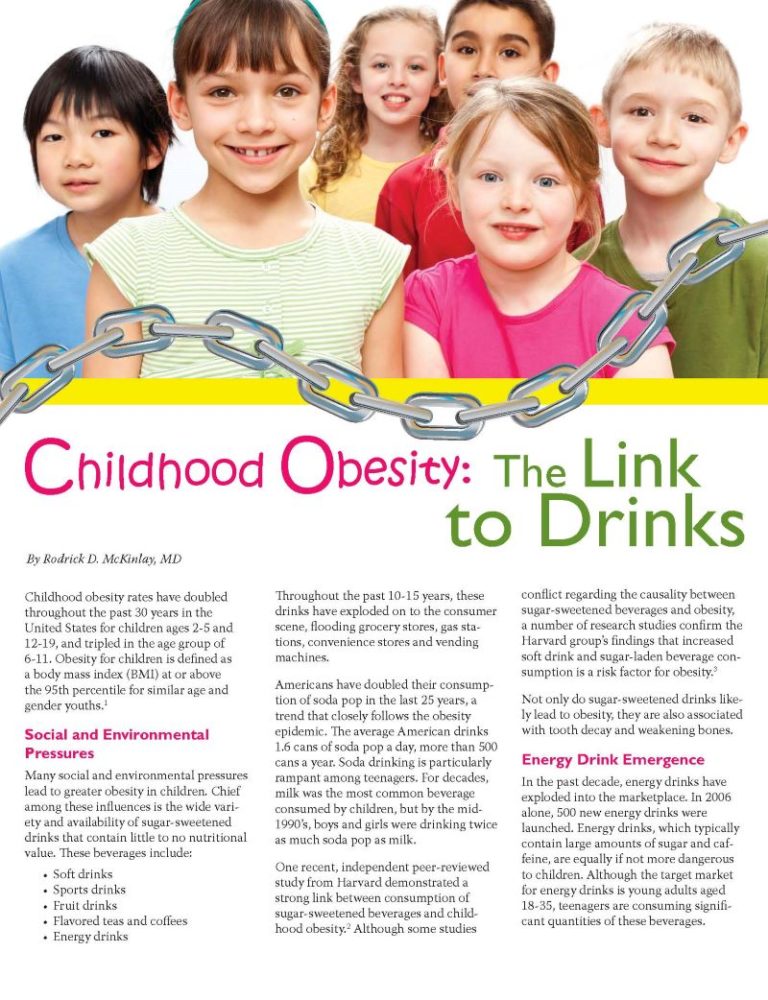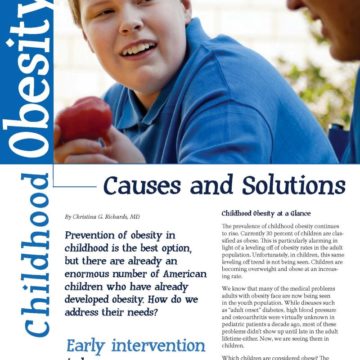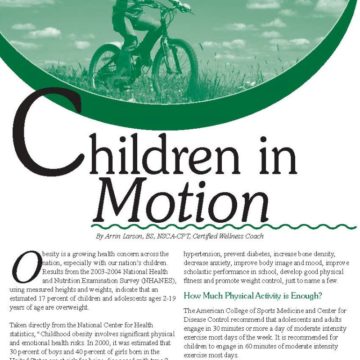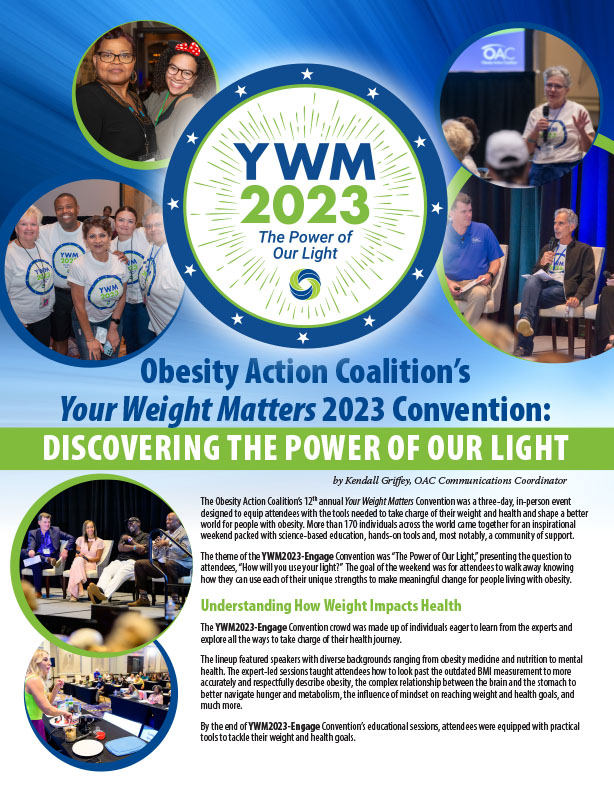Childhood Obesity: The Link to Drinks


by Rodrick D. McKinlay, MD
Fall 2009
Childhood obesity rates have doubled throughout the past 30 years in the United States for children ages 2-5 and 12-19, and tripled in the age group of 6-11. Obesity for children is defined as a body mass index (BMI) at or above the 95th percentile for similar age and gender youths.1
Social and Environmental Pressures
Many social and environmental pressures lead to greater obesity in children. Chief among these influences is the wide variety and availability of sugar-sweetened drinks that contain little to no nutritional value. These beverages include:
- Soft drinks
- Sports drinks
- Fruit drinks
- Flavored teas and coffees
- Energy drinks
Throughout the past 10-15 years, these drinks have exploded on to the consumer scene, flooding grocery stores, gas stations, convenience stores and vending machines.
Americans have doubled their consumption of soda pop in the last 25 years, a trend that closely follows the obesity epidemic. The average American drinks 1.6 cans of soda pop a day, more than 500 cans a year. Soda drinking is particularly rampant among teenagers. Data indicates that soft drinks account for 13 percent of a teenager’s caloric intake – by far the largest source of calories in his or her diet. For decades, milk was the most common beverage consumed by children, but by the mid-1990’s, boys and girls were drinking twice as much soda pop as milk.
One recent, independent peer-reviewed study from Harvard demonstrated a strong link between consumption of sugar-sweetened beverages and childhood obesity.2 Although some studies conflict regarding the causality between sugar-sweetened beverages and obesity, a number of research studies confirm the Harvard group’s findings that increased soft drink and sugar-laden beverage consumption is a risk factor for obesity.3
Not only do sugar-sweetened drinks likely lead to obesity, they are also associated with tooth decay and weakening bones.
Energy Drink Emergence
In the past decade, energy drinks have exploded into the marketplace. In 2006 alone, 500 new energy drinks were launched. Energy drinks, which typically contain large amounts of sugar and caffeine, are equally if not more dangerous to children. Although the target market for energy drinks is young adults aged 18-35, teenagers are consuming significant quantities of these beverages.
Caffeine by the Can
The amounts of caffeine found in such drinks as Red Bull or Rock Star are about 10 grams per ounce. With that in mind, take a look at the amount of caffeine found in other beverages:
- Red Bull (8.3 oz can) = 83 grams
- Rock Star (16 oz. can) = 160 grams
- Coca-Cola Classic (12 oz. can) = 34.5 grams
- Pepsi-Cola (12 oz. can) = 38 grams
- Coffee (8 oz. cup) = 57 grams
Most experts recommend that children consume well under 100 grams of caffeine per day.
Effects of Caffeine on Children
Pharmacologic effects of caffeine are notable in children, most commonly seen as hyperactivity, sleep disturbances and restlessness. Drinking large amounts of caffeine can also be associated with high blood pressure and frequent headaches.
Researchers have reported that a new practice among college-age students is the simultaneous consumption of energy drinks and alcohol, which allows greater consumption of alcohol since alertness is perpetuated by the energy drink.4 In addition, the sugar content of energy drinks is comparable or higher than most soft drinks. For example, an 8 oz Red Bull contains 27 grams of sugar and a 16 oz Rock Star has 60 grams of sugar, while the typical non-diet soft drink contains 40-45 grams of sugar.
How to Combat the High-calorie Beverage Craze
So what can be done to limit the amount of nutritionally-poor liquid calories that children and adolescents are consuming? On an individual-basis, the best approach is simply to replace soda and sports drinks with water or low-fat milk in children’s diets. Water is the best hydrator available. Low-fat milk not only hydrates, but delivers calcium, protein and vitamin D.
Children should be monitored at home with their choice of liquids. A glass of 100 percent fruit juice per day is beneficial, but excessive soda, sport drinks or energy drinks is unhealthy. What happens at school may be out of the immediate control of a parent, but parents can petition the school to eliminate vending machines that sell soft drinks and energy drinks in favor of bottled water.
Moderation in guiding children, of course, is appropriate. Children who are constantly deprived of treats are more likely to binge eat or drink. Also, parental modeling is important. Studies suggest that children who are raised by parents who exert excessive dietary restraint may be more likely to become affected by obesity.5
Children possess the ability to internally regulate their caloric intake. If they see their parents struggle with alternating dis-inhibited eating (abandoning the effort to control food or drink intake) and restrained eating (conscious decision to restrict intake to control weight), they may pattern their own eating and drinking behavior after their parents instead of allowing their internal energy regulation to guide them. This in turn seems to lead to greater obesity in children.
Conclusion
Parents should adopt healthy eating and drinking patterns, limiting consumption of soft drinks and other sugar-sweetened drinks, and to do so without obsession. Helping children develop a love for the refreshing taste of water or a cold glass of milk will pay immediate health rewards for children as well as dividends for their future health and weight control.
About the Author:
Rodrick D. McKinlay, MD, is a certified Center of Excellence bariatric surgeon with Rocky Mountain Associated Physicians (RMAP) in Salt Lake City. Started in 1979, RMAP is one of the longest continuously running weight-loss surgery practices in the United States.
References:
- Childhood Obesity in the United States: Facts and Figures, Fact Sheet 2004, Institute of Medicine.
- Ludwig et al, Relation between consumption of sugar-sweetened drinks and childhood obesity: a prospective, observational analysis. Lancet 2001; Feb 17; 357 (9255):505-8.
- Wolff et al, Medscape J Med 2008; 10(8):189.
- Malinauskas et al, Nutrition Journal 2007; 6:35.
- Hood et al, International Journal of Obesity 2000; 10:1319-1325.
by Sarah Muntel, RD Spring 2024 Spring has sprung, bringing sunnier and warmer days! For many, this…
Read Articleby Michelle “Shelly” Vicari Winter 2024 Winter has arrived! Don’t allow the chilly and damp weather to…
Read Articleby Kendall Griffey, OAC Communications Coordinator Winter 2024 The Obesity Action Coalition’s 12th annual Your Weight Matters…
Read Article








